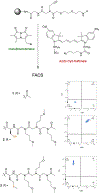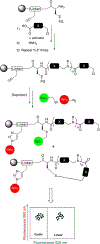High-Throughput Quality Control Assay for the Solid-Phase Synthesis of DNA-Encoded Libraries of Macrocycles*
- PMID: 33682283
- PMCID: PMC8193836
- DOI: 10.1002/anie.202100230
High-Throughput Quality Control Assay for the Solid-Phase Synthesis of DNA-Encoded Libraries of Macrocycles*
Abstract
There is considerable interest in the development of libraries of scaffold-diverse macrocycles as a source of ligands for difficult targets, such as protein-protein interaction surfaces. A classic problem in the synthesis of high-quality macrocyclic libraries is that some linear precursors will cyclize efficiently while some will not, depending on their conformational preferences. We report here a powerful quality control method that can be employed to readily distinguish between scaffolds that do and do not cyclize efficiently during solid-phase synthesis of thioether macrocycles without the need for tedious liquid chromatography/mass spectrometry analysis. We demonstrate that this assay can be employed to identify linear impurities in a DNA-encoded library of macrocycles. We also use the method to establish a useful quality control protocol for re-synthesis of putative macrocyclic screening hits.
Keywords: DNA-encoded libraries; macrocycles; peptidomimetics.
© 2021 Wiley-VCH GmbH.
Conflict of interest statement
Conflict of interest
T.K. is a major shareholder in Deluge Biotechnologies, which is commercializing DNA-encoded libraries of macrocycles.
Figures






Similar articles
-
Synthesis and Screening of a DNA-Encoded Library of Non-Peptidic Macrocycles.Angew Chem Int Ed Engl. 2022 Apr 25;61(18):e202116999. doi: 10.1002/anie.202116999. Epub 2022 Mar 2. Angew Chem Int Ed Engl. 2022. PMID: 35192245 Free PMC article.
-
Large Macrocyclic Libraries via Thioether Cyclization.Methods Mol Biol. 2025;2934:95-103. doi: 10.1007/978-1-0716-4578-9_7. Methods Mol Biol. 2025. PMID: 40663325
-
MacroEvoLution: A New Method for the Rapid Generation of Novel Scaffold-Diverse Macrocyclic Libraries.Chemistry. 2017 Sep 4;23(49):11784-11791. doi: 10.1002/chem.201703209. Epub 2017 Aug 7. Chemistry. 2017. PMID: 28715083 Free PMC article.
-
Recent Advances in Macrocyclic Drugs and Microwave-Assisted and/or Solid-Supported Synthesis of Macrocycles.Molecules. 2022 Feb 2;27(3):1012. doi: 10.3390/molecules27031012. Molecules. 2022. PMID: 35164274 Free PMC article. Review.
-
Strategies for the Diversity-Oriented Synthesis of Macrocycles.Chem Rev. 2019 Sep 11;119(17):10288-10317. doi: 10.1021/acs.chemrev.9b00084. Epub 2019 Jun 20. Chem Rev. 2019. PMID: 31244001 Review.
Cited by
-
Solid-Phase Synthesis of Diverse Macrocycles by Regiospecific 2-Pyridone Formation: Scope and Applications.JACS Au. 2024 Aug 12;4(8):3018-3027. doi: 10.1021/jacsau.4c00352. eCollection 2024 Aug 26. JACS Au. 2024. PMID: 39211620 Free PMC article.
-
Synthesis and direct assay of large macrocycle diversities by combinatorial late-stage modification at picomole scale.Nat Commun. 2022 Jul 2;13(1):3823. doi: 10.1038/s41467-022-31428-8. Nat Commun. 2022. PMID: 35780129 Free PMC article.
-
Recent advances in DNA-encoded dynamic libraries.RSC Chem Biol. 2022 Feb 17;3(4):407-419. doi: 10.1039/d2cb00007e. eCollection 2022 Apr 6. RSC Chem Biol. 2022. PMID: 35441147 Free PMC article. Review.
-
Influence of Macrocyclization Strategies on DNA-Encoded Cyclic Peptide Libraries.JACS Au. 2025 Jun 27;5(7):3399-3407. doi: 10.1021/jacsau.5c00473. eCollection 2025 Jul 28. JACS Au. 2025. PMID: 40747057 Free PMC article.
-
Encoding and display technologies for combinatorial libraries in drug discovery: The coming of age from biology to therapy.Acta Pharm Sin B. 2024 Aug;14(8):3362-3384. doi: 10.1016/j.apsb.2024.04.006. Epub 2024 Apr 10. Acta Pharm Sin B. 2024. PMID: 39220863 Free PMC article. Review.
References
-
- Driggers EM, Hale SP, Lee J, Terrett NK, Nat. Rev. Drug Discovery 2008, 7, 608–624; - PubMed
- Whitty A, Viarengo LA, Zhong M, Org. Biomol. Chem 2017, 15, 7729–7735; - PubMed
- Bauer RA, Wurst JM, Tan DS, Curr. Opin. Chem. Biol 2010, 14, 308–314; - PMC - PubMed
- Dandapani S, Marcaurelle LA, Nat. Chem. Biol 2010, 6, 861–863. - PubMed
-
- Villar EA, Beglov D, Chennamadhavuni S, Porco JA, Kozakov D, Vajda S, Whitty A, Nat. Chem. Biol 2014, 10, 723–731; - PMC - PubMed
- Over B, Matsson P, Tyrchan C, Artursson P, Doak BC, Foley MA, Hilgendorf C, Johnston SE, Lee MD, Lewis RJ, McCarren P, Muncipinto G, Norinder U, Perry MWD, Duvall JR, Kihlberg J, Nat. Chem. Biol 2016, 12, 1065–1074; - PubMed
- Pye CR, Hewitt WM, Schwochert J, Haddad TD, Townsend CE, Etienne L, Lao Y, Limberakis C, Furukawa A, Mathiowetz AM, Price DA, Liras S, Lokey RS, J. Med. Chem 2017, 60, 1665–1672. - PMC - PubMed
-
- Connors WH, Hale SP, Terrett NK, Curr. Opin. Chem. Biol 2015, 26, 42–47. - PubMed
Publication types
MeSH terms
Substances
Grants and funding
LinkOut - more resources
Full Text Sources
Other Literature Sources

